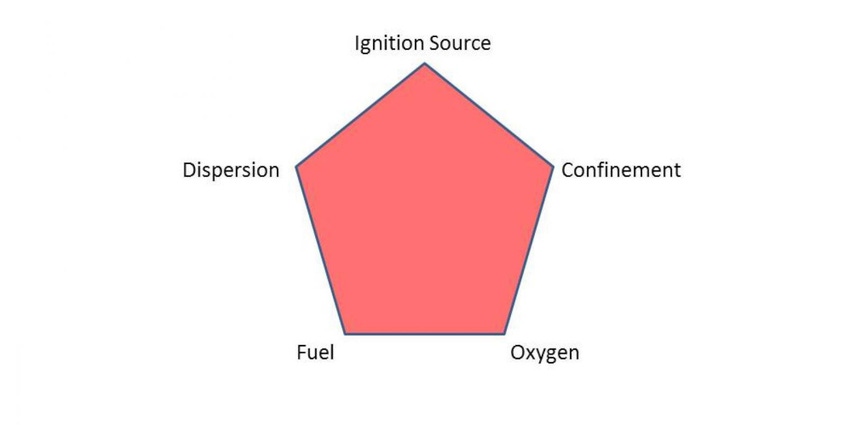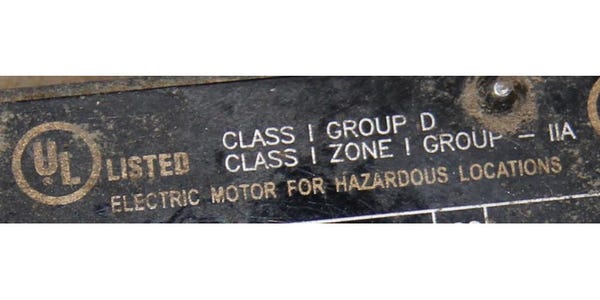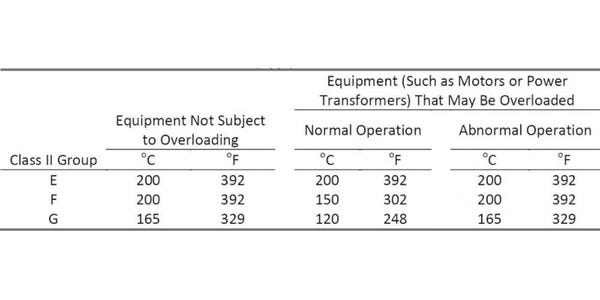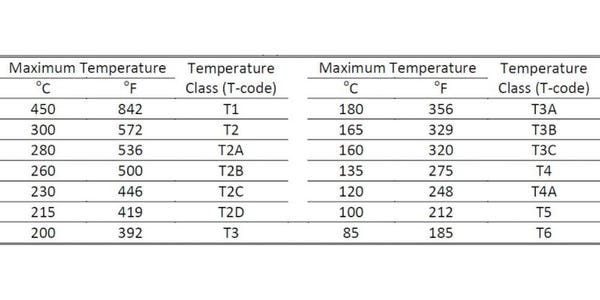Explosion Proof May Not be the Answer
Understanding how dust explosions occur and what electrical equipment is appropriate is critically important when trying to mitigate risk.
July 23, 2014

Justin Bishop, managing electrical engineer; Mark Fecke, senior managing mechanical engineer; Russ Ogle, principle chemical engineer, Exponent
Dust explosions are a known hazard in bulk solid manufacturing and process facilities. In fact, there were 281 confirmed dust incidents from 1980 through 2005. From these, 119 lives have been lost in addition to the 718 injuries resulting from these incidents.1
One technique that is routinely used to mitigate the risk of a dust explosion is the removal of potential ignition sources. Potential ignition sources include, but are not limited to, mechanical ignition sources such as mechanical sparks and frictional heating, chemical ignition sources such as self-heating, spontaneous combustion, or other exothermic reactions, and electrical ignition sources such as static electricity and electrical equipment.
Of the three groups of ignition sources described above, electrical ignition sources are regularly identified as potential ignition sources during dust explosion investigations. During dust explosion investigations, it is routine to find electrical equipment that is not appropriate for the classified (hazardous) location that it is located within even though facilities personnel thought the equipment was appropriate. Understanding how dust explosions occur and what electrical equipment is appropriate for a given classified location are critically important when trying to mitigate the risk of a dust explosion.
Dust Explosion Basics
A dust explosion occurs when a fuel, ignition source, oxygen, confinement, and dispersion come together. This requirement is traditionally depicted using an explosion pentagon as shown above.
If any of the five items identified in the pentagon are removed from the pentagon, an explosion can be prevented. Dust explosion protection becomes stronger as additional items of the pentagon are removed, but some items are more easily managed than others. Electrical ignition sources are one of those more easily managed items, but only if you know what to look for.
Hazardous (Classified) Location Basics
The NEC identifies three specific areas where explosion hazards may exist, as it relates to electrical equipment. These areas are defined as Class I, II, and III. Class I areas are those where an explosion or fire hazard exists due to the presence of flammable gases, flammable liquid-produced vapors, or combustible liquid-produced vapors. Class II areas are those where an explosion or fire hazard exists due to the presence of combustible dusts, and Class III areas are those where an explosion or fire hazard exists due to the presence of ignitable fibers/flyings.2 The NEC refines each Class into either Div. 1 or Div. 2. Additionally, materials such as flammable gases, combustible dusts, etc., that might be considered when evaluating if an area should be classified as a hazardous area per the NEC are separated in to Groups based on their material and physical properties. Representative lists of materials in the material groups may be found in reference material such as National Fire Protection Association (NFPA) 4973 and NFPA 499.4
Bulk solid manufacturing and process facilities likely fall into the Class II (i.e., combustible dusts) area. However, depending on the process, other materials that require Class I or Class III classifications may be possible and should be considered. In order to remove potential electrical ignition sources from an area that has been determined to be hazardous per the NEC, the electrical equipment that will be used and installed in the area needs to be evaluated and confirmed to meet the NEC requirements for electrical equipment within the specific hazardous area.
The NEC describes requirements for electrical equipment that is intended for use in each of the Classes described above and also identifies how to tell if a piece of electrical equipment is appropriate for a given Class, Division, and Group. Remember that electrical equipment within hazardous (classified) locations must be appropriate for not only the Class and Division but also the Group. To get the full benefit of using classified equipment, the equipment must be installed appropriately for the area. Classified equipment may not work properly if it is installed improperly.
Electrical Motors in Class II Locations
Electrical motors are found throughout industry and are commonly found in classified locations. However, based on experience, there is often confusion about what type of motors are appropriate for Class II locations. Two questions that are frequently asked by facility personnel regarding the choice or appropriateness of a given motor are:
1) Is an explosion proof motor appropriate for a Class II, Div. 1 area?
2) Is a totally enclosed, fan-cooled (TEFC) motor appropriate for a Class II, Div. 2 area?
Question 1: Is an explosion proof motor appropriate for Class II, Div. 1 area?
The short answer is maybe, but additional information such as the Group designation for the material in the atmosphere around the equipment is needed. Also, the expression “explosion proof” is associated with Class I equipment while the analogous expression for Class II equipment is “dust-ignition proof.” The NEC addresses this question, in part, in this excerpt from the 2014 edition:5
502.5 Explosionproof Equipment
Explosionproof equipment and wiring shall not be required and shall not be acceptable in Class II locations unless also identified for such locations.
As shown above, there are two parts to the NEC requirement. The first is explosion proof equipment is not required when trying to meet the equipment requirements for Class II, Div. 1 areas. The second part is if explosion proof equipment is chosen, then the equipment must also be identified as being appropriate for a Class II area and must also be identified as being appropriate for the Div. and Group where the equipment will be used.
How could a piece of explosion proof equipment, that is appropriate for a Class I, Div. 1 area, not be appropriate for a Class II, Div. 1 area? To answer this question, one must understand that the hazard or ignition scenario that the equipment is trying to prevent is different for different Classes. Recall that the NEC’s definition of explosion proof equipment is “equipment enclosed in a case that is capable of withstanding an explosion of a specified gas or vapor that may occur within it and of preventing the ignition of a specified gas or vapor surrounding the enclosure by sparks, flashes, or explosion of the gas or vapor within and that operates at such an external temperature that a surrounding flammable atmosphere will not be ignited thereby”6, but the definition of dust-ignition proof equipment is “equipment enclosed in a manner that excludes dusts and does not permit arcs, sparks, or heat otherwise generated or liberated inside of the enclosure to cause ignition of exterior accumulations or atmospheric suspensions of a specified dust on or in the vicinity of the enclosure.”7
As is apparent from the definition, explosion proof equipment is designed to prevent ignition of a specified gas or vapor and not combustible dusts. While explosion proof equipment is designed to prevent the ignition of specified gases or vapors surrounding the equipment when an explosion occurs inside the equipment, explosion proof equipment is not necessarily designed to keep dust from entering the equipment. Additionally, explosion proof equipment is designed so that its max operational temperature will not ignite the surrounding flammable atmosphere. This is similar to the requirement for dust-ignition proof equipment; however, recall that the ignition temperature of flammable gases and vapors is generally higher than the ignition temperature of combustible dust layers.8


Figure 3A and Figure 3B: Representative photographs of nameplates from two different explosion proof motors.
Figure 3A shows a motor name plate that indicates the motor is explosion proof (i.e., appropriate for a Class I, Div. 1 area) but it does not indicate that it is appropriate for Class II areas and therefore would not be appropriate. Additionally, this motor is appropriate for Group D materials but it would not be appropriate for other material Groups. However, some equipment does have a dual rating as the name plate from a different explosion proof motor, shown in Figure 3B, indicates. This motor is appropriate for some Class II, Div. 1 locations. Specifically, this explosion proof motor would be appropriate for Class II, Div. 1 areas where the material (i.e., combustible dust) in the environment around the motor is in either the Group F or G category. This means that this explosion proof motor is not appropriate for environments that contain Group E dusts, which is the other Group designation in Class II, Div. 1 environments.
Question 2: Is a totally enclosed fan-cooled (TEFC) motor appropriate for a Class II, Div. 2 area?
Similar to question 1, the short answer to question 2 is maybe, but additional information such as the Group designation for the material in the atmosphere around the equipment is needed. The 2014 edition of the NEC states that
“In Class II, Division 2 locations, motors, generators, and other rotating electrical equipment shall be totally enclosed nonventilated, totally enclosed, pipe-ventilated, totally enclosed water-air-cooled, totally enclosed fan-cooled, dust-ignition proof for which maximum full-load external temperature shall be in accordance with 500.8(D)(2) for normal operation when operating in free air (not dust blanketed) and shall have no external openings.”9
The first part of the requirement above confirms that the TEFC motor style is appropriate; however, the TEFC motor must also have a maximum full-load external temperature, under normal operating conditions, in accordance with the Table 1 and it must also have no external openings. Note that the maximum full-load external temperature should be in accordance with Table 1, but this does not mean that it can be above the auto ignition temperature of the specific combustible dust to be encountered by the equipment or above 329°F for organic dusts that may dehydrate or carbonize.
In order to determine if a given motor is in accordance with the maximum full-load external temperature requirements and is below the auto ignition temperature of the specific combustible dust being considered, the dust Group classification is needed and the motor’s temperature code (T-code) needs to be verified. Table 2 provides a list of T-codes and their associated maximum temperatures.

Unfortunately, T-codes are not necessarily required on a motor’s name plate unless the motor’s name plate identifies the motor as being approved for a specific Class II, Division 1 hazardous environment.10 In some cases, the only way to determine the motor’s T-code is to contact the motor manufacture and ask them to evaluate the motor. Sometimes the motor manufacture is able to calculate the motor’s T-code and other times the manufacture may not be able to determine the T-code.
What do I do now?
Now that you know what to look for, conduct a classified electric motor survey. Any area of your facility where combustible dusts are handled may be a classified (hazardous) area per the NEC. Do your motors measure up? The only way to find out is to get out on the shop floor and look at motor nameplates. It is not unusual for a facility to have tens if not hundreds of electrical motors, so it is best to get organized. First, determine the proper hazardous area classification for your facility. Remember, some areas of your facility will be classified, some will not. Create a checklist of all the motors in a given area to be surveyed and grab a few essential inspection items:
* A general arrangement drawing
* Notebook or clip board for taking notes
* Flashlight for illuminating dark nameplates
* Machine shop towel for cleaning off dirty nameplates
* Small digital camera for taking photographs of each non-complying motor
Electric motors that are in compliance can be left alone, but if you find a non-complying motor, you will need to decide if you are going to replace it in order to reduce the risk of a dust explosion. You can indicate the location of the motor on the drawing, so you will know where to find the motor later. Document the name plate so you know the motor specification when purchasing a new motor. Once this action is complete and non-complying motors are replaced, you will have taken a significant step toward preventing dust explosions at your facility.
Conclusion
Understanding how dust explosions occur and what electrical equipment is appropriate for a given classified location is critically important when trying to mitigate the risk of a dust explosion. Removal of potential electrical ignition sources is a common technique used to mitigate the risk of dust explosions. However, there continues to be some confusion regarding the type of electrical equipment that is appropriate for Class II locations. For example, an explosion proof motor may not be appropriate for a Class II, Div. 1 location and a TEFC motor may not be appropriate for a Class II, Div. 2 location. Additional, critical information is needed before one can verify if these types of motors are appropriate for the hazardous (classified) location and therefore, meet the goal of reducing the risk of dust explosions by removal of potential electrical ignition sources.
Justin Bishop is a managing electrical engineer, Mark Fecke is a senior managing mechanical engineer, and Russ Ogle is a principle chemical engineer at Exponent. Exponent is a leading engineering and scientific consulting firm that uses a multi-disciplinary approach to investigating, analyzing, and mitigating complicated issues. Contact Bishop at 630-658-7522 or [email protected].
1 US Chemical Safety and Hazard Investigation Board (CSB), “Combustible Dust Hazard Study-Investigation Report,” 2006-H-1, Washington DC, November 2006, page 1
2 National Electrical Code, 2014 edition, article 500
3 NFPA 497: Recommended practice for the classification of flammable liquids, gases, or vapors and of hazardous (classified) locations for electrical installations in chemical process areas, 2012 edition, Chapter 4
4 NFPA 499: Recommended practice for the classification of combustible dusts and of hazardous (classified) locations for electrical installations in chemical process areas, 2013 edition, Chapter 5
5 National Electrical Code, 2014 edition, article 502
6 National Electrical Code, 2014 edition, article 100
7 National Electrical Code, 2014 edition, article 500
8 Electrical Installations in Hazardous Locations, P. J. Schram, R. P. Benedetti, M. W. Earley, 3rd Edition, Chapter 4, 2009
9 National Electrical Code, 2014 edition, article 502
10 National Electrical Code, 2014 edition, article 430 and article 502
You May Also Like

